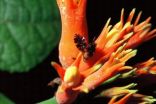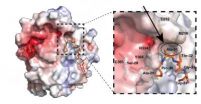(Press-News.org) Numbers and data can be critical tools in bringing complex issues into crisp focus. The understanding of diseases, for example, benefits from algorithms that help monitor their spread. But without context, a number may just be a number, or worse, misleading.
"The Parable of Google Flu: Traps in Big Data Analysis" is published in the journal Science, funded, in part, by a grant from the National Science Foundation. Specifically, the authors examine Google's data-aggregating tool Google Flu Trend (GFT), which was designed to provide real-time monitoring of flu cases around the world based on Google searches that matched terms for flu-related activity.
"Google Flu Trend is an amazing piece of engineering and a very useful tool, but it also illustrates where 'big data' analysis can go wrong," said Ryan Kennedy, University of Houston political science professor. He and co-researchers David Lazer (Northeastern University/Harvard University), Alex Vespignani (Northeastern University) and Gary King (Harvard University) detail new research about the problematic use of big data from aggregators such as Google.
Even with modifications to the GFT over many years, the tool that set out to improve response to flu outbreaks has overestimated peak flu cases in the U.S. over the past two years.
"Many sources of 'big data' come from private companies, who, just like Google, are constantly changing their service in accordance with their business model," said Kennedy, who also teaches research methods and statistics for political scientists. "We need a better understanding of how this affects the data they produce; otherwise we run the risk of drawing incorrect conclusions and adopting improper policies."
GFT overestimated the prevalence of flu in the 2012-2013 season, as well as the actual levels of flu in 2011-2012, by more than 50 percent, according to the research. Additionally, from August 2011 to September 2013, GFT over-predicted the prevalence of flu in 100 out of 108 weeks.
The team also questions data collections from platforms such as Twitter and Facebook (like polling trends and market popularity) as campaigns and companies can manipulate these platforms to ensure their products are trending.
Still, the article contends there is room for data from the Googles and Twitters of the Internet to combine with more traditional methodologies, in the name of creating a deeper and more accurate understanding of human behavior.
"Our analysis of Google Flu demonstrates that the best results come from combining information and techniques from both sources," Kennedy said. "Instead of talking about a 'big data revolution,' we should be discussing an 'all data revolution,' where new technologies and techniques allow us to do more and better analysis of all kinds."
INFORMATION:
When big isn't better: How the flu bug bit Google
The parable of Google flu: Traps in big data analysis
2014-03-13
ELSE PRESS RELEASES FROM THIS DATE:
More to biological diversity than meets the eye
2014-03-13
Most of us already imagine the tropics as a place of diversity—a lush region of the globe teeming with a wide variety of exotic plants and animals. But for researchers Andrew Forbes and Marty Condon, there's even more diversity than meets the eye.
In a paper published in the March 14 issue of the journal Science, Forbes and Condon report the discovery of extraordinary diversity and specialization in the tropics.
The paper builds upon previous research conducted by Condon, who discovered surprising diversity while researching plant species in South America. Later, she, ...
Saving large carnivores in the ecosystem requires multifaceted approach
2014-03-13
Carnivore management is not just a numbers game, Virginia Tech wildlife scientists assert in response to an article in the Jan. 10 issue of the journal Science that urged "minimum population densities be maintained for persistence of large carnivores, biodiversity, and ecosystem structure."
"This type of approach may fail in social carnivore species," said Kathleen Alexander, an associate professor of fisheries and wildlife conservation in the College of Natural Resources and Environment. "Predator management is incredibly complex and we need to be extremely cautious ...
Unraveling a mystery in the 'histone code' shows how gene activity is inherited
2014-03-13
Cold Spring Harbor, NY – Every cell in our body has exactly the same DNA, yet every cell is different. A cell's identity is determined by the subset of genes that it activates. But how does a cell know which genes to turn off and which to turn on? While the genetic code carried in our DNA provides instructions for cells to manufacture specific proteins, it is a second code that determines which genes are in fact activated in particular cell types.
This second code is carried by proteins that attach to DNA. The code-carrying proteins are called histones. Today, researchers ...
Understanding how mountains and rivers make life possible
2014-03-13
Favorable conditions for life on Earth are enabled in part by the natural shuttling of carbon dioxide from the planet's atmosphere to its rocky interior and back again. Now Stanford scientists have devised a pair of math equations that better describe how topography, rock compositions and the movement of water through a landscape affects this vital recycling process.
Scientists have long suspected that the so-called the geologic carbon cycle is responsible for Earth's clement and life-friendly conditions because it helps regulate atmospheric concentrations of carbon dioxide, ...
Deficient protein GM-CSF production found to impair gut's immune tolerance
2014-03-13
New York, NY – The protein GM-CSF plays a critical role in maintaining immune tolerance in the gut, with defects in the protein increasing the susceptibility to inflammatory bowel diseases (IBD), according to a new mouse study by a team of researchers from the Icahn School of Medicine at Mount Sinai. IBD is a severe intestinal disease characterized by chronic intestinal inflammation that results from a dysregulated immune response to microbes and food antigens. Writing in the peer reviewed journal Science published online March 13, 2014, the research team writes that this ...
Stirring the simmering 'designer baby' pot
2014-03-13
(Garrison, NY) From genetic and genomic testing to new techniques in human assisted reproduction, various technologies are providing parents with more of a say about the children they have and "stirring the pot of 'designer baby' concerns," writes Thomas H. Murray, President Emeritus of The Hastings Center, in a commentary in Science.
Murray calls for a national conversation about how much discretion would-be parents should have. "Preventing a lethal disease is one thing; choosing the traits we desire is quite another," he writes.
He discusses public hearings two weeks ...
Roomy cages built from DNA
2014-03-13
VIDEO:
To create supersharp images of their cage-shaped DNA polyhedral, the scientists used DNA-PAINT, a microscopy method that uses short strands of DNA (yellow) labeled with a fluorescent chemical (green) to...
Click here for more information.
BOSTON, March 13, 2014 – Move over, nanotechnologists, and make room for the biggest of the small. Scientists at the Harvard's Wyss Institute have built a set of self-assembling DNA cages one-tenth as wide as a bacterium. The structures ...
One in 5 older Americans take medications that work against each other
2014-03-13
PORTLAND, Ore. – About three out of four older Americans have multiple chronic health conditions, and more than 20 percent of them are being treated with drugs that work at odds with each other – the medication being used for one condition can actually make the other condition worse.
This approach of treating conditions "one at a time" even if the treatments might conflict with one another is common in medicine, experts say, in part because little information exists to guide practitioners in how to consider this problem, weigh alternatives and identify different options.
One ...
These boosts are made for walkin'
2014-03-13
Whether you're a Major League outfielder chasing down a hard-hit ball or a lesser mortal navigating a busy city sidewalk, it pays to keep a close watch on your surroundings when walking or running. Now, new research by UC San Francisco neuroscientists suggests that the body may get help in these fast-changing situations from a specialized brain circuit that causes visual system neurons to fire more strongly during locomotion.
There has been a great deal of research on changes among different brain states during sleep, but the new findings, reported in the March 13 issue ...
Some racial disparities in childbirth more environmental than genetic
2014-03-13
A new study investigating racial disparities in birth outcomes shows that contrary to some theories Vitamin D is unlikely to play a role in differences in preterm birth and low birth weight between African-Americans and whites.
"For years there has been this hypothesis that African-Americans have worse birth outcomes because they have more melanin in their skin which reflects the sun and therefore lowers levels of Vitamin D," said study author Zaneta Thayer, PhD, assistant professor of anthropology at the University of Colorado Denver . "But in examining the relationship ...
LAST 30 PRESS RELEASES:
Penn researchers awarded $25M to conduct trial using smartphones to fight heart disease
PCORI awards funding for new patient-centered healthcare research
Exploring the origins of the universe: 145 low-noise amplifiers complete ALMA telescopes
Empress cicada wings help illuminate molecular structure
Using sound waves to detect helium
Time burden in patients with metastatic breast and ovarian cancer from clinic and home demands
Researchers discover bias in AI models that analyze pathology samples
Scientists ID potential way to prevent brain injuries from triggering Alzheimer's
MASTER 2nd Open Call: Execution period kick-off
Algae for health in food and pharma
Advanced microrobots driven by acoustic and magnetic fields for biomedical applications
Chicago health information leader recognized for raising CPR readiness and blood pressure awareness
The Intimate Animal, a new book from Kinsey Institute Executive Director Dr. Justin Garcia
When blue-collar workers lose union protection, they try self-employment
New video dataset to advance AI for health care
MEA-based graph deviation network for early autism syndrome signatures in human forebrain organoids
New modeling approach sheds light on rare gut disease
Study documents potentially hazardous flame retardants in firefighter gear
Can certain bacteria regulate aging of the immune system and its related alterations?
AI model helps diagnose often undetected heart disease from simple EKG
There are fewer online trolls than people think
Cell membrane fluctuations produce electricity
Jeonbuk National University study shows positive parenting can protect adolescents against self-harm
Surface-engineered ZnO nanocrystals to tackle perfluoroalkyl substance contamination
This new understanding of T cell receptors may improve cancer immunotherapies
A new fossil face sheds light on early migrations of ancient human ancestor
A new immunotherapy approach could work for many types of cancer
A new way to diagnose deadly lung infections and save lives
40 percent of MRI signals do not correspond to actual brain activity
How brain-inspired algorithms could drive down AI energy costs
[Press-News.org] When big isn't better: How the flu bug bit GoogleThe parable of Google flu: Traps in big data analysis




